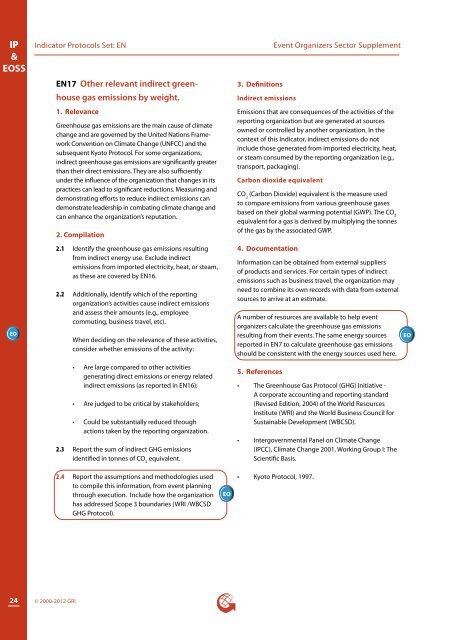Event Organizers Sector Supplement - Global Reporting Initiative
Event Organizers Sector Supplement - Global Reporting Initiative
Event Organizers Sector Supplement - Global Reporting Initiative
You also want an ePaper? Increase the reach of your titles
YUMPU automatically turns print PDFs into web optimized ePapers that Google loves.
IP<br />
&<br />
EOSS<br />
EO<br />
Indicator Protocols Set: EN<br />
EN17 Other relevant indirect greenhouse<br />
gas emissions by weight.<br />
1. Relevance<br />
Greenhouse gas emissions are the main cause of climate<br />
change and are governed by the United Nations Framework<br />
Convention on Climate Change (UNFCC) and the<br />
subsequent Kyoto Protocol. For some organizations,<br />
indirect greenhouse gas emissions are significantly greater<br />
than their direct emissions. They are also sufficiently<br />
under the influence of the organization that changes in its<br />
practices can lead to significant reductions. Measuring and<br />
demonstrating efforts to reduce indirect emissions can<br />
demonstrate leadership in combating climate change and<br />
can enhance the organization’s reputation.<br />
2. Compilation<br />
2.1 Identify the greenhouse gas emissions resulting<br />
from indirect energy use. Exclude indirect<br />
emissions from imported electricity, heat, or steam,<br />
as these are covered by EN16.<br />
2.2 Additionally, identify which of the reporting<br />
organization’s activities cause indirect emissions<br />
and assess their amounts (e.g., employee<br />
commuting, business travel, etc).<br />
When deciding on the relevance of these activities,<br />
consider whether emissions of the activity:<br />
• Are large compared to other activities<br />
generating direct emissions or energy related<br />
indirect emissions (as reported in EN16);<br />
• Are judged to be critical by stakeholders;<br />
• Could be substantially reduced through<br />
actions taken by the reporting organization.<br />
2.3 Report the sum of indirect GHG emissions<br />
identified in tonnes of CO 2<br />
equivalent.<br />
3. Definitions<br />
Indirect emissions<br />
<strong>Event</strong> <strong>Organizers</strong> <strong>Sector</strong> <strong>Supplement</strong><br />
Emissions that are consequences of the activities of the<br />
reporting organization but are generated at sources<br />
owned or controlled by another organization. In the<br />
context of this Indicator, indirect emissions do not<br />
include those generated from imported electricity, heat,<br />
or steam consumed by the reporting organization (e.g.,<br />
transport, packaging).<br />
Carbon dioxide equivalent<br />
CO 2<br />
(Carbon Dioxide) equivalent is the measure used<br />
to compare emissions from various greenhouse gases<br />
based on their global warming potential (GWP). The CO 2<br />
equivalent for a gas is derived by multiplying the tonnes<br />
of the gas by the associated GWP.<br />
4. Documentation<br />
Information can be obtained from external suppliers<br />
of products and services. For certain types of indirect<br />
emissions such as business travel, the organization may<br />
need to combine its own records with data from external<br />
sources to arrive at an estimate.<br />
A number of resources are available to help event<br />
organizers calculate the greenhouse gas emissions<br />
resulting from their events. The same energy sources<br />
reported in EN7 to calculate greenhouse gas emissions<br />
should be consistent with the energy sources used here.<br />
5. References<br />
• The Greenhouse Gas Protocol (GHG) <strong>Initiative</strong> -<br />
A corporate accounting and reporting standard<br />
(Revised Edition, 2004) of the World Resources<br />
Institute (WRI) and the World Business Council for<br />
Sustainable Development (WBCSD).<br />
• Intergovernmental Panel on Climate Change<br />
(IPCC), Climate Change 2001, Working Group I: The<br />
Scientific Basis.<br />
EO<br />
2.4 Report the assumptions and methodologies used<br />
to compile this information, from event planning<br />
through execution. Include how the organization<br />
has addressed Scope 3 boundaries (WRI /WBCSD<br />
GHG Protocol).<br />
EO<br />
• Kyoto Protocol, 1997.<br />
24<br />
© 2000-2012 GRI

















